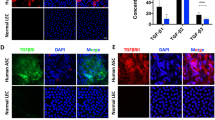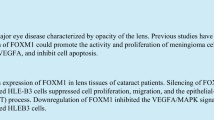Abstract
Background
Posterior capsule opacification occurs mainly due to the remnant lens epithelial cell proliferation and migration after cataract surgery. The purpose of this study was to investigate whether small hairpin RNA (shRNA)-mediated gene silencing of transcription factor forkhead box E3 (FOXE3) can be employed to inhibit the expression of FOXE3 and suppress the growth in lens epithelial cells.
Methods
FOXE3-targeted shRNA was transfected into a human lens epithelial cell line (HLEB-3) using Lipofectamine 2000 reagent. Quantitative PCR was used to confirm the downregulation of FOXE3 mRNA expression following infection of lens epithelial cells, and FOXE3 protein expression levels were evaluated by Western blot analysis and immunofluoresence staining. HLEB-3 cell growth after the transduction was analyzed by cell counting and MTT colorimetric assay. Cell cycle of the HLEB-3 cells was examined by flowcytometric analysis.
Results
Compared with the control groups, both mRNA and protein levels of FOXE3 expression were significantly decreased in shRNA-treated groups, and cytostatic effects were obvious within 48 h after transfection. An increased incidence of G1-phase arrest was identified in FOXE3-shRNA transfected HLEB-3 cells.
Conclusions
shRNA-mediated gene silencing of FOXE3 could significantly inhibit cell growth and induce the G1-phase arrest in HLEB-3 cells. Formation of posterior capsular opacification might be repressed if lens epithelial cell growth ceases after the FOXE3 gene is silenced with molecular biology technology.




Similar content being viewed by others
References
Clark DS (2000) Posterior capsule opacification. Curr Opin Ophthalmol 11:56–64
Huang Y, Xie L (2010) Short-term outcomes of dry pars plana posterior capsulotomy and anterior vitrectomy in paediatric cataract surgery using 25-gauge instruments. Br J Ophthalmol 94:1024–1027
Peng Q, Visessook N, Apple DJ, Pandey SK, Werner L, Escobar-Gomez M, Schoderbek R, Solomon KD, Guindi A (2000) Surgical prevention of posterior capsule opacification. Part 3: intraocular lens optic barrier effect as a second line of defense. J Cataract Refract Surg 26:198–213
Apple DJ, Solomon KD, Tetz MR, Assia EI, Holland EY, Legler UF, Tsai JC, Castaneda VE, Hoggatt JP, Kostick AM (1992) Posterior capsule opacification. Surv Ophthalmol 37:73–116
Blixt A, Mahlapuu M, Aitola M, Pelto-Huikko M, Enerback S, Carlsson P (2000) A forkhead gene, FoxE3, is essential for lens epithelial proliferation and closure of the lens vesicle. Genes Dev 14:245–254
Brownell I, Dirksen M, Jamrich M (2000) Forkhead Foxe3 maps to the dysgenetic lens locus and is critical in lens development and differentiation. Genesis 27:81–93
Reis LM, Tyler RC, Schneider A, Bardakjian T, Stoler JM, Melancon SB, Semina EV (2010) FOXE3 plays a significant role in autosomal recessive microphthalmia. Am J Med Genet A 152A:582–590
Shi X, Luo Y, Howley S, Dzialo A, Foley S, Hyde DR, Vihtelic TS (2006) Zebrafish foxe3: roles in ocular lens morphogenesis through interaction with pitx3. Mech Dev 123:761–782
Iseri SU, Osborne RJ, Farrall M, Wyatt AW, Mirza G, Nurnberg G, Kluck C, Herbert H, Martin A, Hussain MS, Collin JR, Lathrop M, Nurnberg P, Ragoussis J, Ragge NK (2009) Seeing clearly: the dominant and recessive nature of FOXE3 in eye developmental anomalies. Hum Mutat 30:1378–1386
Medina-Martinez O, Brownell I, Amaya-Manzanares F, Hu Q, Behringer RR, Jamrich M (2005) Severe defects in proliferation and differentiation of lens cells in Foxe3 null mice. Mol Cell Biol 25:8854–8863
Landgren H, Blixt A, Carlsson P (2008) Persistent FoxE3 expression blocks cytoskeletal remodeling and organelle degradation during lens fiber differentiation. Invest Ophthalmol Vis Sci 49:4269–4277
Huang Y, Xie L (2010) Expression of transcription factors and crystallin proteins during rat lens regeneration. Mol Vis 16:341–352
Swindell EC, Zilinski CA, Hashimoto R, Shah R, Lane ME, Jamrich M (2008) Regulation and function of foxe3 during early zebrafish development. Genesis 46:177–183
Meissner A, Noack T (2008) Proliferation of human lens epithelial cells (HLE-B3) is inhibited by blocking of voltage-gated calcium channels. Pflugers Arch 457:47–59
Andley UP, Rhim JS, Chylack LT Jr, Fleming TP (1994) Propagation and immortalization of human lens epithelial cells in culture. Invest Ophthalmol Vis Sci 35:3094–3102
Fleming TP, Song Z, Andley UP (1998) Expression of growth control and differentiation genes in human lens epithelial cells with extended life span. Invest Ophthalmol Vis Sci 39:1387–1398
Mukhopadhyay P, Bhattacherjee P, Andom T, Geoghegan TE, Andley UP, Paterson CA (1999) Expression of prostaglandin receptors EP4 and FP in human lens epithelial cells. Invest Ophthalmol Vis Sci 40:105–112
Yang J, Luo L, Liu X, Rosenblatt MI, Qu B, Liu Y (2010) Down regulation of the PEDF gene in human lens epithelium cells changed the expression of proteins vimentin and alphaB-crystallin. Mol Vis 16:105–112
Jackson AL, Bartz SR, Schelter J, Kobayashi SV, Burchard J, Mao M, Li B, Cavet G, Linsley PS (2003) Expression profiling reveals off-target gene regulation by RNAi. Nat Biotechnol 21:635–637
Blixt A, Landgren H, Johansson BR, Carlsson P (2007) Foxe3 is required for morphogenesis and differentiation of the anterior segment of the eye and is sensitive to Pax6 gene dosage. Dev Biol 302:218–229
Acknowledgments
This study was supported by the National Natural Science Foundation of China (30600698 and 30901637).
Author information
Authors and Affiliations
Corresponding author
Additional information
Ye Wang and Wenfeng Li contributed equally to this work
Rights and permissions
About this article
Cite this article
Wang, Y., Li, W., Wang, Y. et al. Growth inhibition of human lens epithelial cells by short hairpin RNA in transcription factor forkhead box E3 (FOXE3). Graefes Arch Clin Exp Ophthalmol 250, 999–1007 (2012). https://doi.org/10.1007/s00417-012-1944-5
Received:
Revised:
Accepted:
Published:
Issue Date:
DOI: https://doi.org/10.1007/s00417-012-1944-5




